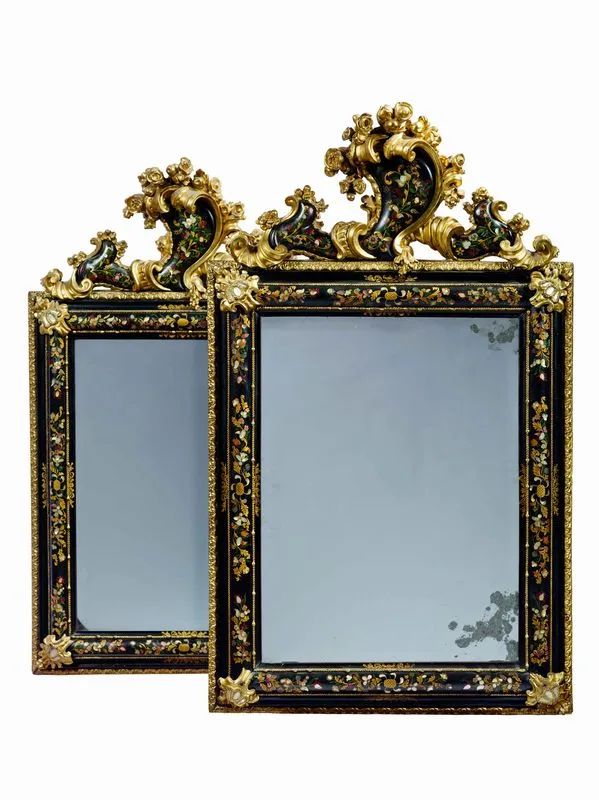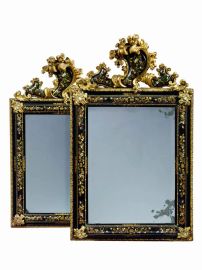15
PAIR OF MIRRORS, VENICE, SECOND QUARTER OF THE 18TH CENTURYPAIR OF MIRRORS, VENICE, SECOND QUARTER OF THE 18TH CENTURY in ebonized, lacquered and gilded wood with mother of pearl marquetry and foliage in sculpted and gilded wood, 168x98 cm This pair of frames is a typical and refined expression of the early rococo atmosphere in Venice during the second quarter of the 18th century. This was a moment in time in which the gilded mirror passed from being mostly used for private grooming to constituting a furnishing element in its own right, over a progressive process of emancipation. During this still transitory phase, during which each city exhibited its own decorative techniques, Venice became one of the main protagonists, laying the foundation for a decorative style that will constitute a key influence for the coming decades. Over the course of the 18th century, the creation of these artefacts is so deeply rooted in the venetian lagoon that within the guild of the marangoni, or woodworkers, there developed a specific branch of highly specialized master carvers, the marangoni de soaza. At the same time, there was a multiplication of workshops managed by soaza artisans: 36 workshops with 94 masters, 124 workers and 24 helpers according to a 1773 statistic polled by the magistrates and trade regulators of the Savi della Mercanzia. The venetian masters did not shy away from letting their creativity run loose, using an ornamentation technique at which they excelled, enamelling, in which the decoration, drawn on a monochrome stucco base is then polished with a layer of varnish, called sandracca. It was in this way that the same kinds of ornamentations which decorated chests and other furnishings went on to embellish mirror-frames, animating them with exotic themes, or chinoiserie. A particular predilection is reserved for decorations modelled after flowers and of oriental inspiration which, drawn vividly and with narrative gusto, stand out with their rich colours against the neutral, often dark backgrounds, alternated with branches and leaves and creating an exuberant but at the same time composedly elegant picture. When a given commission is particularly important, these decorations may also be further enriched by evocative pearl inlays, as with the red and gold lacquered wood frame made in Venice at the end of the 17th century and currently held in the Gemäldegalerie in Berlin (fig. 1), or the one probably dating from the early 18th century and held in a private collection (fig. 2). It is also the case of our two frames, which were probably requested by an important family for a significant occasion. The combination of lacquer and pearl was a venetian prerogative between the late 17th and early 18th centuries. Many carvers produced this kind of decoration, among whom we must mention the architect, engraver, carver, and inlayer Domenico Rossetti, famous for his “works with pearl and in the Chinese style”. This pictorial richness was paralleled by an equal sculptural vivacity, which expressed itself – as well as in the creation of frames in a wide array of styles and shapes – in adding further elements of carved wood to the frames. Additions in sculpted and gilded wood are often attached to the four outer corners of the frame. We can see this in our pair’s ogival motif, creating a kind of counter-frame which was supposed to make the mirror stand out against the wall. But a greater importance is without doubt given to the coping, a necessary crowning of the upper part of the mirror. In the carving of this component, the venetian masters let their creative imagination run wild, showing off their whole repertory of leaves, shells, festoons, and, as in the present case, cartouches, often made so that they would hold a family crest or, as is the case here, decorated with the same pictorial motifs embellished with pearl that are found on the main body of the frame. Almost as if replying to the painted floral motifs, the coping is populated by elements in painted and carved wood, made with a mastery fully on par with that of the expert and imaginative master painters. In our mirror-frames, flower and fruit alternated with leafy folds frame the central coping, the asymmetrical position of which creates a decentred effect typical of the 18th century, whilst the four corners of the frames are marked – symmetrically this time – by small sculpted and polished folders in the middle of the pearl component. And whilst often in this kind of mirror-frame the sculptural element tends to dominate over the pictorial one, concentrating the focal point of attention on the coping, here the overall composition is characterized by a marked equilibrium, in which all elements, both sculptural and pictorial, cohabit and form a harmonious whole. In this sense, these mirror-frames can be fully included in early rococo production, when the festive and daring baroque evolved into lines which – whilst still dominated by an inventive force and capricious exuberance – reflected the period’s more graceful and refined taste. During these few years, many sculptors and woodcarvers place their art in the service of frame-making, including Antonio Gai, Antonio Corradini, or Andrea Brustolon, noted for having made multiple frames alongside the furnishings for the Venier family, now held in Palazzo Rezzonico. Following his drawing, the luxurious throne for the church of the Gesuati in Venice was made in the early 18th century (fig. 3). Its precious pearl inlays, together with its folds and rich wooden sculpted and gilded flowers, constitute one of the first examples of a decorative taste which will exercise much influence over the following decades. Our mirror-frames, thus, may be included precisely in this current. Comparative literature G. Mariacher, Specchiere italiane e cornici da specchio, dal XV al XIX secolo, Milan 1963, pp. 16-24; E. Colle, Il mobile barocco in Italia, Milan 2000, p. 332; C. Santini, Mille mobili veneti. L’arredo domestico in Veneto dal sec. XV al sec. XIX, III, Modena 2002, pp. 246-247 nn. 424-426 PAIR OF MIRRORS, VENICE, SECOND QUARTER OF THE 18TH CENTURY in ebonized, lacquered and gilded wood with mother of pearl marquetry and foliage in sculpted and gilded wood, 168x98 cm This pair of frames is a typical and refined expression of the early rococo atmosphere in Venice during the second quarter of the 18th century. This was a moment in time in which the gilded mirror passed from being mostly used for private grooming to constituting a furnishing element in its own right, over a progressive process of emancipation. During this still transitory phase, during which each city exhibited its own decorative techniques, Venice became one of the main protagonists, laying the foundation for a decorative style that will constitute a key influence for the coming decades. Over the course of the 18th century, the creation of these artefacts is so deeply rooted in the venetian lagoon that within the guild of the marangoni, or woodworkers, there developed a specific branch of highly specialized master carvers, the marangoni de soaza. At the same time, there was a multiplication of workshops managed by soaza artisans: 36 workshops with 94 masters, 124 workers and 24 helpers according to a 1773 statistic polled by the magistrates and trade regulators of the Savi della Mercanzia. The venetian masters did not shy away from letting their creativity run loose, using an ornamentation technique at which they excelled, enamelling, in which the decoration, drawn on a monochrome stucco base is then polished with a layer of varnish, called sandracca. It was in this way that the same kinds of ornamentations which decorated chests and other furnishings went on to embellish mirror-frames, animating them with exotic themes, or chinoiserie. A particular predilection is reserved for decorations modelled after flowers and of oriental inspiration which, drawn vividly and with narrative gusto, stand out with their rich colours against the neutral, often dark backgrounds, alternated with branches and leaves and creating an exuberant but at the same time composedly elegant picture. When a given commission is particularly important, these decorations may also be further enriched by evocative pearl inlays, as with the red and gold lacquered wood frame made in Venice at the end of the 17th century and currently held in the Gemäldegalerie in Berlin (fig. 1), or the one probably dating from the early 18th century and held in a private collection (fig. 2). It is also the case of our two frames, which were probably requested by an important family for a significant occasion. The combination of lacquer and pearl was a venetian prerogative between the late 17th and early 18th centuries. Many carvers produced this kind of decoration, among whom we must mention the architect, engraver, carver, and inlayer Domenico Rossetti, famous for his “works with pearl and in the Chinese style”. This pictorial richness was paralleled by an equal sculptural vivacity, which expressed itself – as well as in the creation of frames in a wide array of styles and shapes – in adding further elements of carved wood to the frames. Additions in sculpted and gilded wood are often attached to the four outer corners of the frame. We can see this in our pair’s ogival motif, creating a kind of counter-frame which was supposed to make the mirror stand out against the wall. But a greater importance is without doubt given to the coping, a necessary crowning of the upper part of the mirror. In the carving of this component, the venetian masters let their creative imagination run wild, showing off their whole repertory of leaves, shells, festoons, and, as in the present case, cartouches, often made so that they would hold a family crest or, as is the case here, decorated with the same pictorial motifs embellished with pearl that are found on the main body of the frame. Almost as if replying to the painted floral motifs, the coping is populated by elements in painted and carved wood, made with a mastery fully on par with that of the expert and imaginative master painters. In our mirror-frames, flower and fruit alternated with leafy folds frame the central coping, the asymmetrical position of which creates a decentred effect typical of the 18th century, whilst the four corners of the frames are marked – symmetrically this time – by small sculpted and polished folders in the middle of the pearl component. And whilst often in this kind of mirror-frame the sculptural element tends to dominate over the pictorial one, concentrating the focal point of attention on the coping, here the overall composition is characterized by a marked equilibrium, in which all elements, both sculptural and pictorial, cohabit and form a harmonious whole. In this sense, these mirror-frames can be fully included in early rococo production, when the festive and daring baroque evolved into lines which – whilst still dominated by an inventive force and capricious exuberance – reflected the period’s more graceful and refined taste. During these few years, many sculptors and woodcarvers place their art in the service of frame-making, including Antonio Gai, Antonio Corradini, or Andrea Brustolon, noted for having made multiple frames alongside the furnishings for the Venier family, now held in Palazzo Rezzonico. Following his drawing, the luxurious throne for the church of the Gesuati in Venice was made in the early 18th century (fig. 3). Its precious pearl inlays, together with its folds and rich wooden sculpted and gilded flowers, constitute one of the first examples of a decorative taste which will exercise much influence over the following decades. Our mirror-frames, thus, may be included precisely in this current. Comparative literature G. Mariacher, Specchiere italiane e cornici da specchio, dal XV al XIX secolo, Milan 1963, pp. 16-24; E. Colle, Il mobile barocco in Italia, Milan 2000, p. 332; C. Santini, Mille mobili veneti. L’arredo domestico in Veneto dal sec. XV al sec. XIX, III, Modena 2002, pp. 246-247 nn. 424-426
















